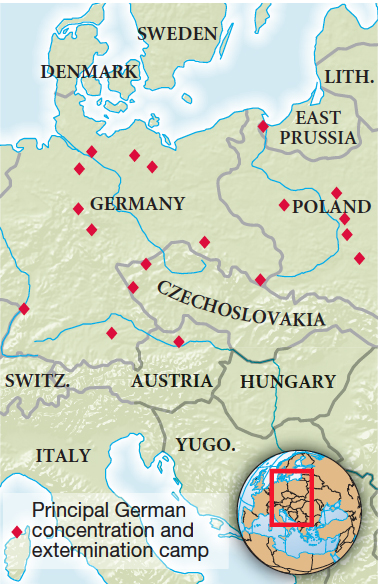Reaction to the Holocaust.
Printed Page 700 Chapter Chronology

Reaction to the Holocaust. Since the 1930s, the Nazis had persecuted Jews in Germany and every German-occupied territory, causing many Jews to seek asylum beyond Hitler's reach. Thousands of Jews sought to immigrate to the United States, but 82 percent of Americans opposed admitting them, and they were turned away. In 1942, numerous reports reached the United States that Hitler was sending Jews, Gypsies, religious and political dissenters, homosexuals, and others to concentration camps, where old people, children, and others deemed too weak to work were systematically slaughtered and cremated, while the able-bodied were put to work at slave labor until they died of starvation and abuse. Other camps were devoted almost exclusively to murdering and cremating Jews. Despite reports of the brutal slave labor and killing camps, U.S. officials refused to grant asylum to Jewish refugees. Most Americans, including top officials, believed that reports were exaggerated.

Desperate to stem the killing, the World Jewish Congress appealed to the Allies to bomb the death camps and the railroad tracks leading to them in order to hamper the killing and block further shipments of victims. Intent on achieving military victory as soon as possible, the Allies repeatedly turned down such bombing requests, arguing that the air forces could not spare resources from their military missions.
The nightmare of the Holocaust was all too real. When Russian troops arrived at Auschwitz in Poland in January 1945, they found emaciated prisoners, skeletal corpses, gas chambers, pits filled with human ashes, and loot the Nazis had stripped from the dead, including hair, gold fillings, and false teeth. At last, the truth about the Holocaust began to be known beyond the Germans who had perpetrated and tolerated these atrocities and the men, women, and children who had succumbed to the genocide. By then, it was too late for the 11 million civilian victims — mostly Jews — of the Nazis' crimes against humanity.
Holocaust
German effort during World War II to murder Europe's Jews, along with other groups the Nazis deemed "undesirable." Despite reports of the ongoing genocide, the Allies did almost nothing to interfere. In all, some 11 million people were killed in the Holocaust, most of them Jews.